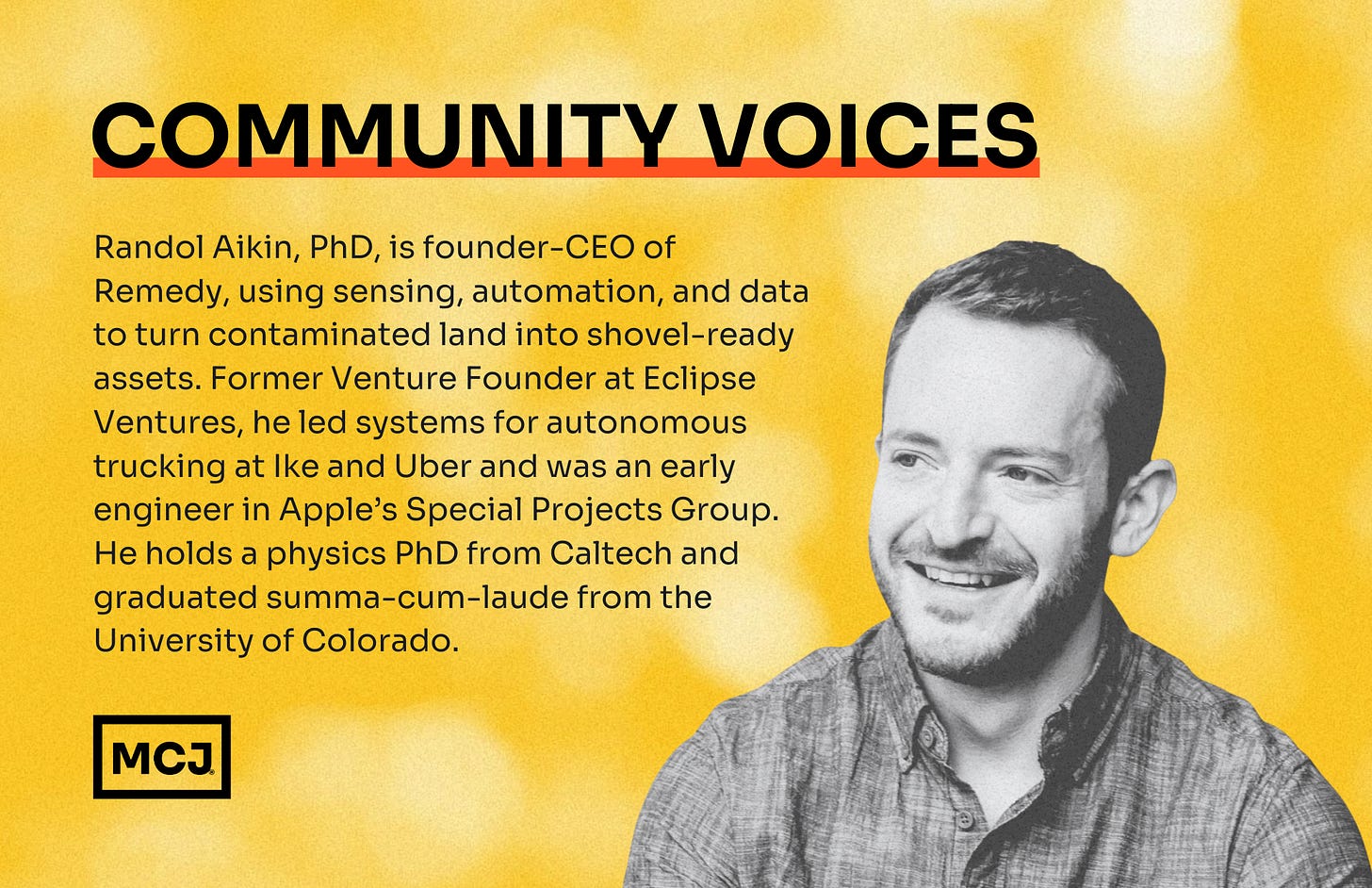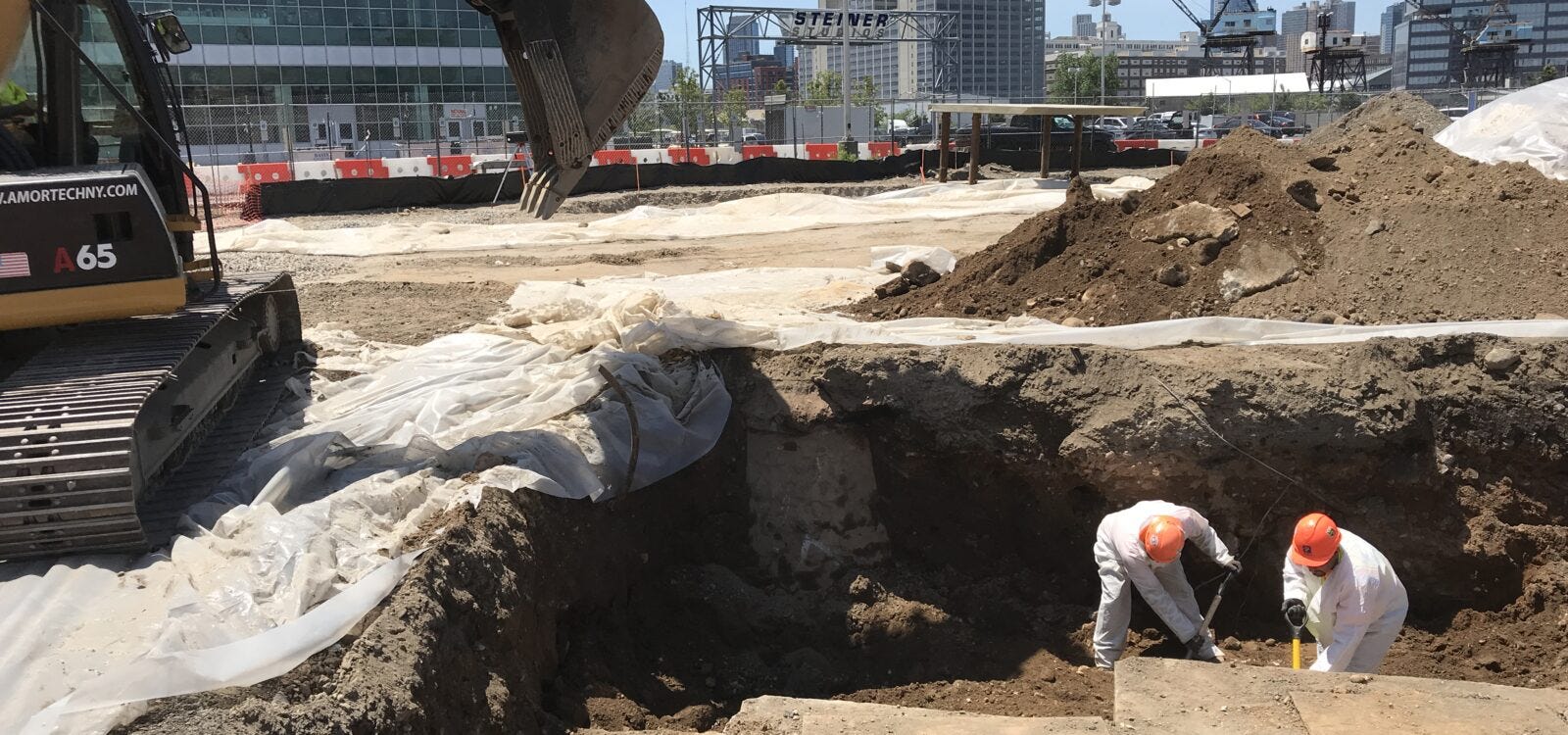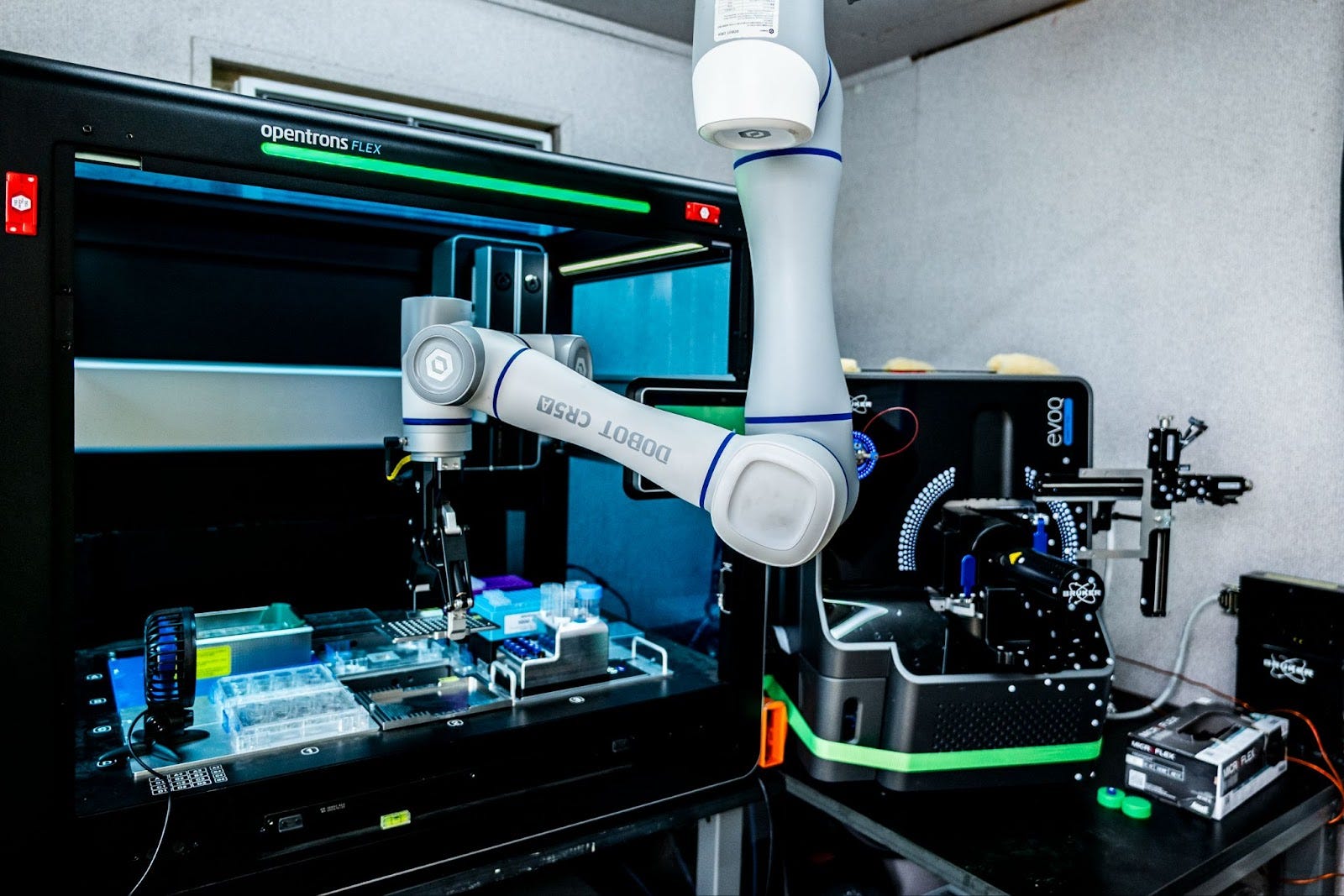The Dirty Ground Blocking our Clean Energy Future
by Randol Aikin, CEO and Founder at Remedy Scientific
When discussing accelerated climate solutions, the narratives are clear. We imagine gleaming wind farms, solar arrays, resilient housing, and zero-emission transportation networks. But there’s an invisible obstacle hindering this vision, literally beneath our feet. That issue is contaminated land. Over 450,000 brownfields and Superfund sites remain idle in the United States, their toxic past locking them into limbo. These sites, often positioned in high-demand areas, represent some of the most valuable but underutilized opportunities for progress.
Everywhere we look, we see the dominating effect that energy, transportation, and industrialization have had on land use. To realize a future of carbon-free manufacturing, mining, transportation, and energy production, we must repurpose millions of acres of land globally in a way that reverses the centuries-long legacy of pollution. At our current rate of cleanup, this will continue to be a hidden drag on the carbon-free transition.
The Scale of the Problem
To make the point concrete: Since 2000, roughly 770 coal-fired generating units have been retired in the United States, creating prime locations for energy-storage projects. Boston Consulting Group projects that up to 25 percent of gas stations will shut down over the next decade, opening thousands of potential sites for EV chargers. Meanwhile, extreme weather events such as hurricanes and wildfires continue to leave fresh environmental catastrophes in their wake. Energy distribution, advanced manufacturing, mining, and climate-resilient housing all face the same obstacle: past land use has left a legacy of contamination that must be addressed before any low-carbon future can be built.
Environmental cleanup practices today aren’t keeping up. We still rely on old methods: crews dig and haul contaminated soil with excavators and dump trucks, groundwater is cycled through pump-and-treat systems for years, and many sites are left to “monitored natural attenuation,” where engineers simply collect samples while nature works at its own pace. Add soil-vapor blowers, long-running biopiles, and repeat chemical injections. The result is a patchwork of labor-heavy approaches that can stretch for decades, tying up land that could otherwise host clean-energy projects or climate-resilient housing.
And of course, the human health consequences are significant. Consider PFAS, a group of chemicals so ubiquitous that they now exist in the bloodstreams of 99% of human beings. The Department of Defense (DoD) has already spent $2.6 billion addressing PFAS releases since 2017 and estimates another $9.3 billion will be required beyond 2025. Yet even with this massive investment, we’ve barely scratched the surface.
It is tempting to blame the slow rollout of high-speed rail and renewable projects on regulatory red tape. Environmental reviews can run for years, and legacy contamination can stop construction before it starts. Yet that explanation is too simple. What we truly need are better technologies that allow us to speed toward a carbon-free economy, while still protecting human health and ecosystems.
Old School Cleanup Meets New Tech
The emergence of modular remediation technologies is finally poised to shake up an industry long stuck in its ways. For decades, the environmental management industry has trended toward consolidation and “brains for hire” business models. But that outlook is shifting dramatically, thanks in part to new trends in adjacent industries.
In defense procurement, the United States has moved from open-ended time-and-materials contracts toward buying finished products and turnkey services. Instead of paying contractors to invent a new radar or aircraft from scratch on the government’s clock, agencies now prefer proven platforms, subscription software, and fixed-price service bundles that arrive with clear performance guarantees. Environmental remediation sits today where defense once did: dominated by bespoke engineering studies, change orders, and cost overruns. It needs the same leap to standardized, factory-built treatment units and data services that can be ordered, installed, and validated with predictable cost and schedule.
Recent advances have made this leap possible in the near term. Rugged industrial compute and automation software can feasibly fully automate treatment skids that can run around the clock with minimal human oversight. Off-the-shelf liquid-handling robots slash the cost and turnaround time of sample analysis by processing hundreds of samples per shift. Large language models can absorb the resulting flood of data, producing clear reports, regulatory filings, and work plans in a fraction of the usual desk time. Together, these technologies shrink both the physical and administrative bottlenecks that have long slowed cleanups.
Bridging the Gap Through Policy and Investment
New technology alone will not transform contaminated land; policymakers must pair it with incentives that make cleanup attractive instead of relying solely on penalties. These incentives do not have to be subsidies: they can include fast-track permitting, selective zoning relief, or liability indemnification. At every level of government, we should publish clear metrics on site closures (recent legislation introduced by Reps. Rivet and Bergman is a clear step in that direction). Standardized, rule-based screening limits would then give engineers clear targets and give landowners confidence that cleanup investments will unlock their property.
Similarly, greater coordination between federal and local regulators could eliminate administrative redundancies, moving projects from approval to implementation far more efficiently.
On the investment side, capital is key to remediation-specific innovations. Venture capitalists, sustainability-focused funds, and large-scale donors must assess this challenge as both a moral obligation and a profit-driven opportunity. Technological transformation of the remediation sector can not only unlock potentially trillions in land value but is also an absolute necessity for a transition to a carbon-neutral economy.
Land Use 3.0: Building the Future on Clean Ground
We’re at the brink of a new era in land use, redefining how we approach development and remediation.
Land Use v1.0 (1700–1970): Build fast, abandon polluted sites, and move on.
Land Use v2.0 (1970–2025): Recognize the damage. Enforce accountability and strict regulations, often shifting dirty industries offshore.
Land Use v3.0 (2025 onward): Reimagine what’s possible. Every shuttered factory, dormant parking lot, or polluted site can be transformed into housing, green space, or renewable infrastructure. We don’t need to wait decades to act—new technologies make it possible now.
Advanced sensing, software, and automation technologies have an enormous role to play in transforming industrial properties into future development opportunities. As the defense, mining, and finance sectors show, startups likewise have a critical role to play to prove new business models and ways of working. Remedy is hard at work on this mission every day. But we can’t do it alone. Policymakers, investors, and innovators must come together to unlock the full potential of land remediation.
The future demands bold action—and it starts today. Let’s build smarter, cleaner, and faster. To learn more or join us in shaping this future, contact info@remedyscientific.com.
🎙️ Inevitable Podcast
📈 Renowned climate scientist Dr. Michael Mann joins us to discuss the evolving public perception of climate change, the fight against misinformation, and what he sees as a coordinated effort to delay climate action. From the legacy of the "hockey stick graph" to his latest book Our Fragile Moment, Dr. Mann offers an unflinching look at the political and media forces shaping the climate narrative today.
🎥 The Lean Back
Stanford’s Dr. Mark Jacobson explains his view on renewable energy.
👩💻 Climate Jobs
Check out the Job Openings space in the MCJ Collective member hub or the MCJ Job Board for more.
Quality Engineer at Base (Austin, TX)
Regulatory Policy Manager at Charm (San Francisco, CA)
Travel Data Product & Partnerships Manager at Clarasight (Toronto, ON)
Staff Software Engineer, Managed AI at Crusoe (San Francisco, CA)
Finance & Strategy Associate at Euclid (Remote)
Power Electronics Engineer at Mill (San Bruno, CA)
Senior Cyber Security Engineer at The Nuclear Company (Columbia, SC)
Purchasing Manager at Pacific Fusion (San Leandro, CA)
Senior Research Associate at Windfall Bio (San Mateo, CA)
🗓️ Mark Your Calendar
Women in Climate - July: This monthly virtual meetup is for women working in, or aspiring to work in, climate and the energy transition. This month’s guests are Sumreen Rattan, co-founder of Moment Energy, who will discuss battery storage and circularity, and Alex Young from Energy Impact Partners, who will share insights on hardtech and investment trends in the energy transition. (July 30)
The MCJ Newsletter is a FREE weekly email curating news, jobs, Inevitable podcast episodes, and other noteworthy happenings in the MCJ Collective community.
💭 If you have feedback or items you’d like to include, feel free to reach out.
🤝 If you’d like to join the MCJ Collective, apply today.
💡 Have a climate-related event or content topic that you'd like to see in the MCJ newsletter? Email us at content@mcj.vc





It's time to drop the antinuke cult membership.
Cleaning contaminated land gets a heck of a lot easier, along with EVERY other kind of pollution cleanup, as industrial quality energy gets cheaper.
Updated nuclear can be 10x cheaper if we want it to be, while improving on the great safety record and reducing fuel use and spent fuel accumulation. "waste".
There would be no climate change if everyone followed France's lead in the 1980's and went a bit farther to get transport fuels on synth net-zero hydrocarbons made with nuclear energy, and get district heating on nuclear energy.
But you don't want all that...
You just want to sing...
Even the World Bank is now reversing 66 years of neglecting the global south and will finance nuclear with the IAEA.
Really fascinating piece! Very timely too as I was just in DC with Citizens' Climate trying to lobby for permitting reform. Brown field site redevelopment sounds like an excellent area for categorical exclusion - especially using some of the new technologies described here. I also like the Land Use 3.0 framework. Often with renewables, criticism focuses on renewables "wasting" land when we're already wasting it in the current policy framework. Billions of acres are wasted on corn for ethanol, and it sounds like millions of acres are being wasted under slow-scale remediation